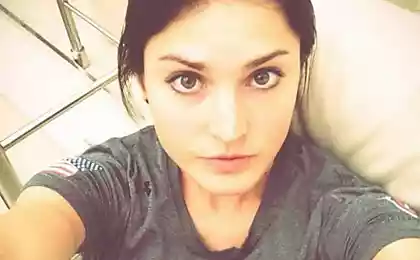203
6 best exercise equipment for powerful muscles
Block simulators have a number of unique advantages: they help to focus better on the target muscles, do not require concentration on maintaining balance and stabilization, and also give constant tension throughout the amplitude of movement. These 6 simulators are actively used in their training all bodybuilders-champions.
1. Undoubtedly, one of the best simulators, which, in addition, can be used for a variety of exercises and muscle groups. In the simulator, Smith can pump the press, make lunges, deadlift and thrust of the barbell in the slope. Allows controlled basic exercises with large weights, you can do controlled. Perhaps the most versatile simulator ever built.
2. The best of the insulating exercises for quadriceps are considered standard squats with a barbell on the shoulders. But the foot press in a special simulator has its advantages. First, this simulator allows you to use the full range of motion - it can literally press quadricips to the chest itself. And secondly, changing the position of the legs on the platform, you can accentuate the load on different problem muscle groups. The setting of the legs is wider - and the muscles of the inner surface of the thigh work more. The legs are already - and the quadriceps and the rest of the muscles of the outer part of the thigh are more included. Above the legs on the platform - and a large load receive gluteal muscles and biceps of the thigh. Below - and more thigh muscles work.
3. The exercise in the Gakkenschmidt simulator is perhaps the only one that can be considered a complete analogue of classical squats in terms of muscle load. But it’s technically much easier to do, allowing you to focus better on the quadriceps without worrying about the position of the lumbar – even with really large weights. As in the leg press, here you can also change the position of the feet and, thus, more to involve certain muscle groups.
4. This simulator calls one of his favorite 8-time Mr. Olympia Ronnie Coleman, and not by chance: the traction of the T-string to the belt allows you to work out the back muscles perfectly and, if necessary, can completely replace the classic thrust of the barbell in the slope. At the same time, the muscles responsible for stabilizing and maintaining balance are less involved, which makes it possible to focus on loading the spinal muscles. An additional advantage of the simulator is that it allows you to use different types of grips and, accordingly, focus the load on various back muscles.
5. Butterfly simulator This simulator can be used both for the pectoral muscles and for the posterior deltas, without thinking about controlling the direction of the movement vector, isolating the desired muscles and ensuring constant tension throughout the movement. A great stimulus for muscle growth gives the maximum amplitude of movements - both during dilution and when reducing hands. Tip: do not “throw” weight – do not perform movements by inertia, bring them to the end slowly and smoothly.
6. Push-ups from bars with its own weight or with pancakes on an athletic belt fixed at the waist are an excellent exercise for working out the chest muscles. However, this is not the only purpose of this trainer. It also allows you to load and work the triceps. To perform push-ups on triceps, sit in the simulator with your back to its base, and apply your chest forward, arching your shoulders slightly back.
P.S. And remember, just changing our consumption – together we change the world!
Source: fitfixed.com
1. Undoubtedly, one of the best simulators, which, in addition, can be used for a variety of exercises and muscle groups. In the simulator, Smith can pump the press, make lunges, deadlift and thrust of the barbell in the slope. Allows controlled basic exercises with large weights, you can do controlled. Perhaps the most versatile simulator ever built.
2. The best of the insulating exercises for quadriceps are considered standard squats with a barbell on the shoulders. But the foot press in a special simulator has its advantages. First, this simulator allows you to use the full range of motion - it can literally press quadricips to the chest itself. And secondly, changing the position of the legs on the platform, you can accentuate the load on different problem muscle groups. The setting of the legs is wider - and the muscles of the inner surface of the thigh work more. The legs are already - and the quadriceps and the rest of the muscles of the outer part of the thigh are more included. Above the legs on the platform - and a large load receive gluteal muscles and biceps of the thigh. Below - and more thigh muscles work.
3. The exercise in the Gakkenschmidt simulator is perhaps the only one that can be considered a complete analogue of classical squats in terms of muscle load. But it’s technically much easier to do, allowing you to focus better on the quadriceps without worrying about the position of the lumbar – even with really large weights. As in the leg press, here you can also change the position of the feet and, thus, more to involve certain muscle groups.
4. This simulator calls one of his favorite 8-time Mr. Olympia Ronnie Coleman, and not by chance: the traction of the T-string to the belt allows you to work out the back muscles perfectly and, if necessary, can completely replace the classic thrust of the barbell in the slope. At the same time, the muscles responsible for stabilizing and maintaining balance are less involved, which makes it possible to focus on loading the spinal muscles. An additional advantage of the simulator is that it allows you to use different types of grips and, accordingly, focus the load on various back muscles.
5. Butterfly simulator This simulator can be used both for the pectoral muscles and for the posterior deltas, without thinking about controlling the direction of the movement vector, isolating the desired muscles and ensuring constant tension throughout the movement. A great stimulus for muscle growth gives the maximum amplitude of movements - both during dilution and when reducing hands. Tip: do not “throw” weight – do not perform movements by inertia, bring them to the end slowly and smoothly.
6. Push-ups from bars with its own weight or with pancakes on an athletic belt fixed at the waist are an excellent exercise for working out the chest muscles. However, this is not the only purpose of this trainer. It also allows you to load and work the triceps. To perform push-ups on triceps, sit in the simulator with your back to its base, and apply your chest forward, arching your shoulders slightly back.
P.S. And remember, just changing our consumption – together we change the world!
Source: fitfixed.com






















